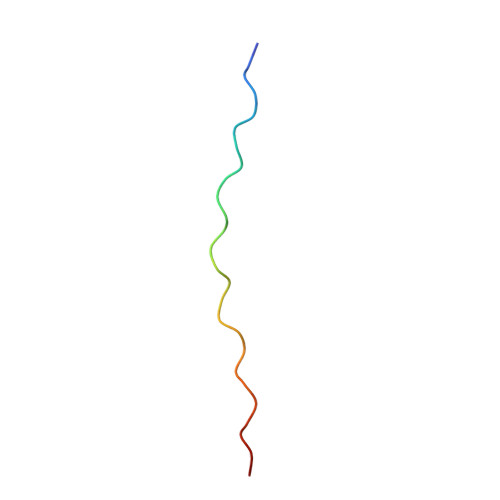Repetitive interactions observed in the crystal structure of a collagen-model peptide, [(Pro-Pro-Gly)9]3
Hongo, C., Noguchi, K., Okuyama, K., Tanaka, Y., Nishino, N.(2005) J Biochem 138: 135-144
- PubMed: 16091587
- DOI: https://doi.org/10.1093/jb/mvi108
- Primary Citation of Related Structures:
2CUO - PubMed Abstract:
The crystal structure of a collagen-model peptide [(Pro-Pro-Gly)(9)](3) has been determined at 1.33 A resolution. Diffraction data were collected at 100 K using synchrotron radiation, which led to the first structural study of [(Pro-Pro-Gly)(n)](3) under cryogenic conditions. The crystals belong to the P2(1) space group with cell parameters of a = 25.95, b = 26.56, c = 80.14 Angstroms and beta = 90.0 degrees. The overall molecular conformation was consistent with the left-handed 7/2-helical model with an axial repeat of 20 A for native collagen. A total of 332 water molecules were found in an asymmetric unit. Proline residues in adjacent triple-helices exhibited three types of hydrophobic interactions. Furthermore, three types of hydrogen-bonding networks mediated by water molecules were observed between adjacent triple-helices. These hydrophobic interactions and hydrogen-bonding networks occurred at intervals of 20 Angstroms along the c-axis based on the previous sub-cell structures [(Pro-Pro-Gly)(n)](3) (n = 9, 10), which were also seen in the full-cell structure of [(Pro-Pro-Gly)(10)](3). Five proline residues at the Y position in the X-Y-Gly triplet were found in a down-puckering conformation, this being inconsistent with the recently proposed propensity-based hypothesis. These proline residues were forced to adopt opposing puckering because of the prevailing hydrophobic interaction between triple-helices compared with the Pro:Pro stacking interaction within a triple-helix.
Organizational Affiliation:
Faculty of Technology, Tokyo University of Agriculture & Technology, Koganei.














